五上unit5导学案
- 格式:docx
- 大小:42.37 KB
- 文档页数:18
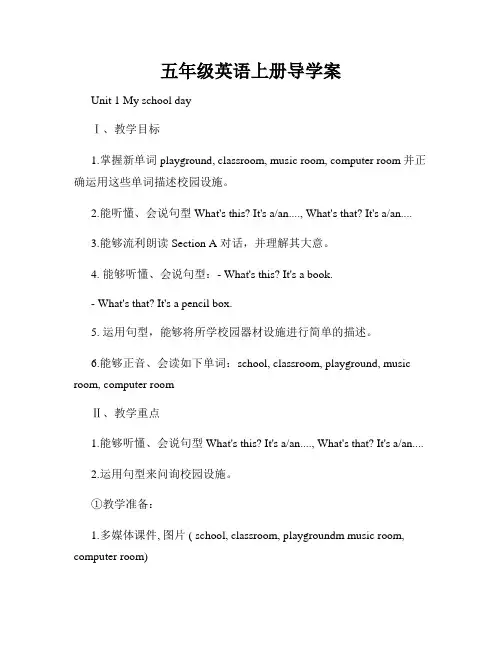
五年级英语上册导学案Unit 1 My school dayⅠ、教学目标1.掌握新单词playground, classroom, music room, computer room并正确运用这些单词描述校园设施。
2.能听懂、会说句型What's this? It's a/an...., What's that? It's a/an....3.能够流利朗读Section A 对话,并理解其大意。
4. 能够听懂、会说句型:- What's this? It's a book.- What's that? It's a pencil box.5. 运用句型,能够将所学校园器材设施进行简单的描述。
6.能够正音、会读如下单词:school, classroom, playground, music room, computer roomⅡ、教学重点1.能够听懂、会说句型What's this? It's a/an...., What's that? It's a/an....2.运用句型来问询校园设施。
①教学准备:1.多媒体课件, 图片 ( school, classroom, playgroundm music room, computer room)2.音频资料,3.教学小黑板, 讨论文具②教学过程Step 1: Warming-up1. Greeting: T: Good morning, class. S1: Good morning, Miss/Mr. T. (学生自由回答,能够体现出英文问候的基本能力).2.Leading in: Teacher shows some pictures (School, classroom……), the teacher introduce the contents of the class, in order to let the students pay attention to the class, Through pictures let the students know the contents and objects of the class.Step 2: PresentationAsk: Is this our school? Is this the playground?Introduce some flashcards: The picture of School, Classroom, Playground, Music room and Computer room, then show the flashcards and Teacher introduces the word School, Classroom, Playground, Music room and Computer room (with the help of PPT, cards and real objects). Group show and Pictrue show, students echo, and then consolidation 3-4 times to ensure understanding. Finally, ask students to do simple dialogue like this:Students: What's this? And the rest of the students answer in chorus, Teacher: It's a Classroom.At this time, the expression can be clicked on the ppt board, zoom in, students echo.Step 3: Practice1. Listen and tick. Sum up the new words and teacher says the new words. Music room. Computer room, then explain:要求学生熟练掌握四个字母在单词中的读音。
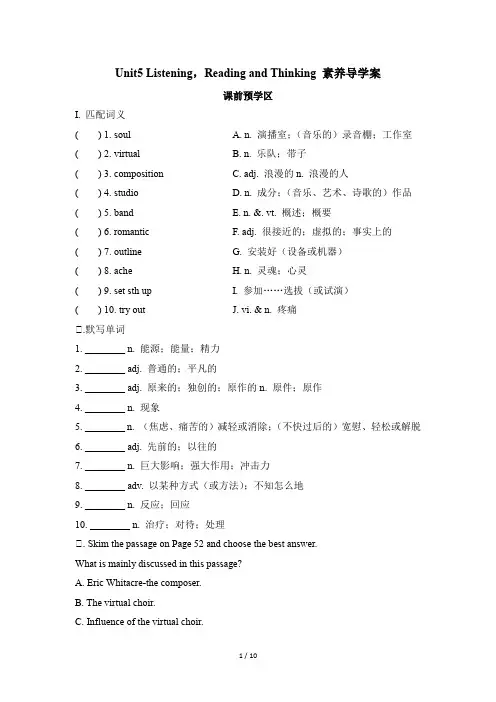
Unit5 Listening,Reading and Thinking 素养导学案课前预学区I. 匹配词义( ) 1. soul A. n. 演播室;(音乐的)录音棚;工作室( ) 2. virtual B. n. 乐队;带子( ) 3. composition C. adj. 浪漫的n. 浪漫的人( ) 4. studio D. n. 成分;(音乐、艺术、诗歌的)作品( ) 5. band E. n. &. vt. 概述;概要( ) 6. romantic F. adj. 很接近的;虚拟的;事实上的( ) 7. outline G. 安装好(设备或机器)( ) 8. ache H. n. 灵魂;心灵( ) 9. set sth up I. 参加……选拔(或试演)( ) 10. try out J. vi. & n. 疼痛Ⅱ.默写单词1. ________n. 能源;能量;精力2. ________adj. 普通的;平凡的3. ________adj. 原来的;独创的;原作的n. 原件;原作4. ________n. 现象5. ________n. (焦虑、痛苦的)减轻或消除;(不快过后的)宽慰、轻松或解脱6. ________adj. 先前的;以往的7. ________n. 巨大影响;强大作用;冲击力8. ________adv. 以某种方式(或方法);不知怎么地9. ________n. 反应;回应10. ________n. 治疗;对待;处理Ⅱ. Skim the passage on Page 52 and choose the best answer.What is mainly discussed in this passage?A. Eric Whitacre-the composer.B. The virtual choir.C. Influence of the virtual choir.D. Compositions of Eric Whitacre.Ⅱ. 话题探究(选做题)Recite the following sayings about music and voice your own opinion about music according to them.1. Music has charms to soothe a savage breast, to soften rocks or bend a knotted oak.(William Congreve)2. Sunshine can burn you; food can poison you; words can condemn you; pictures can insult you;music cannot punish-only bless.(Artur Schnabel)3. Music is the universal language of mankind.(Henry Wadsworth Longfellow)课中导学区研读教材Task 1 Pre-readingLook at the following pictures and answer the questions.1. Match each band with its name.(1)________(2)________(3)________(4)________ (5)________A. The BeatlesB. The Backstreet BoysC. Twelve Girls BandD. The EaglesE. Beyond2. Can you list some songs of each band?__________________________________________________________________________________________________________________________________________ 3. Which band do you like best? Why?_____________________________________________________________________ _____________________________________________________________________ Task 2While-reading1. Read the passage on Page 52 and match the main idea with each paragraph. ( ) (1)Para. 1 A. The creation and the development of the virtual choir.( ) (2)Para. 2 B. What the virtual choir means and its significance.( ) (3)Para. 3 C. Eric Whitacre’s life before the creation of the virtual choir. ( ) (4)Para. 4 D. The virtual choir is making the world a better place.2. Read the passage on Page 52 carefully and choose the correct answers.(1)What is the correct order of making a virtual choir?a. Upload these videos onto the Internet.b. Put all videos together into one.c. Record yourself while you perform alone on video.d. See a virtual choir online.A. cabdB. bcadC. dabeD. abed(2)What is the author’s attitude towards the virtual choir?A. Negative(消极的).B. Positive.C. Objective.D. Doubtful.(3)When did Eric Whitacre fall in love with Mozart’s classical music?A. He began studying music.B. He received a video of a girl.C. He graduated from university.D. He sang for the university choir.(4)When was the Virtual Youth Choir for UNICEF first seen on stage?A. ln1988.B. In1997.C. 1n2009.D. In 2014.Task 3 Post-reading1. Fill in the blanks according to the passage on Page 52.2. According to the passage on Page 52, how do you understand “the virtual choir”? _____________________________________________________________________ _____________________________________________________________________ _____________________________________________________________________3.What impact do virtual choirs have on our lives?_____________________________________________________________________ __________________________________________________________________________________________________________________________________________课堂思学区夯实基础I. 完成句子1. This is the first time in my life that Isuch a grand celebration. 这是我有生以来第一次参加如此盛大的庆典。
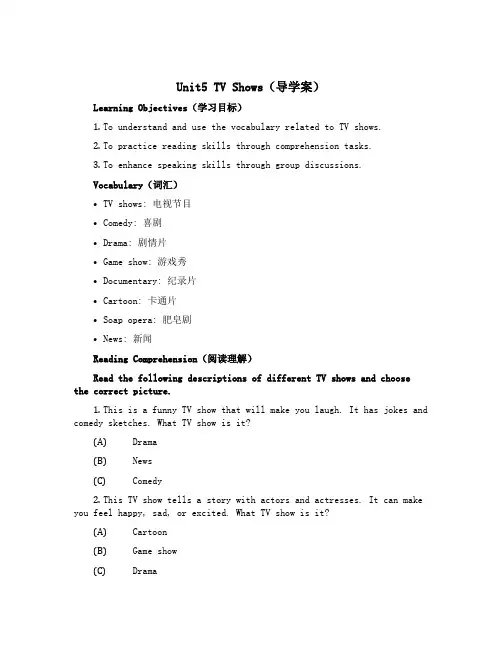
Unit5 TV Shows(导学案)Learning Objectives(学习目标)1.To understand and use the vocabulary related to TV shows.2.To practice reading skills through comprehension tasks.3.To enhance speaking skills through group discussions.Vocabulary(词汇)•TV shows: 电视节目•Comedy: 喜剧•Drama: 剧情片•Game show: 游戏秀•Documentary: 纪录片•Cartoon: 卡通片•Soap opera: 肥皂剧•News: 新闻Reading Comprehension(阅读理解)Read the following descriptions of different TV shows and choosethe correct picture.1.This is a funny TV show that will make you laugh. It has jokes and comedy sketches. What TV show is it?(A)Drama(B)News(C)Comedy2.This TV show tells a story with actors and actresses. It can make you feel happy, sad, or excited. What TV show is it?(A)Cartoon(B)Game show(C)Drama3.This TV show has questions and answers. The contestants win prizes by giving the right answers. What TV show is it?(A)Soap opera(B)Documentary(C)Game show4.This TV show is about real people and real events. It tells a story that is important and interesting. What TV show is it?(A)News(B)Documentary(C)Drama)Match the vocabulary word to its definition1.________ TV shows2.________ Comedy3.________ Drama4.________ Game show5.________ Documentary6.________ Cartoon7.________ Soap opera8.________ News(A) A type of TV show with fictional characters and a storyline that follows them through different situations.(B) A type of TV show with animated characters that entertain children and adults alike.(C) A type of TV show that provides information about current events and occurrences.(D) A type of TV show that presents real information about people, events, and situations.(E) A type of TV show with humor and funny moments that is meant to make people laugh.(F) A type of TV show that centers around a group of people, their relationships, and their struggles.(G) A type of TV show where contestants answer questions for prizes.(H) A type of TV show that frequently airs and follows the same storyline over several episodes or seasons.Speaking Practice(口语练习)Group Discussion:Discuss with your group which TV show you like the most and why. Be sure to use words and phrases related to TV shows and give specific reasons for your choice.Example prompts:•What is your favorite TV show and why do you like it?•Which TV show makes you laugh the most?•Which TV show do you find the most exciting and why?•Which TV show has characters that you can relate to the most?Conclusion(总结)This unit has introduced us to different types of TV shows and the vocabulary associated with them. We have also practiced our reading and speaking skills to improve our comprehension and ability to express ourselves. Understanding TV shows can help us to better understand different cultures and perspectives, and we can use this knowledge to enrich our lives.。
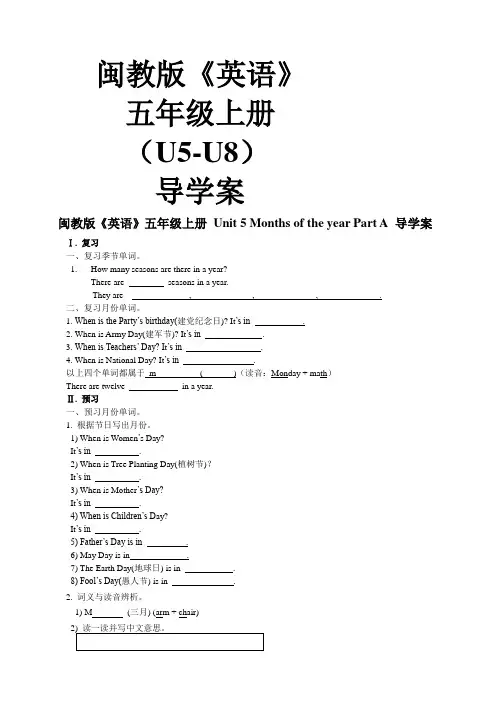
闽教版《英语》五年级上册(U5-U8)导学案闽教版《英语》五年级上册Unit 5 Months of the year Part A导学案Ⅰ. 复习一、复习季节单词。
1. ----How many seasons are there in a year?-------There are seasons in a year.They are , , , .二、复习月份单词。
1. When is the Party’s birthday(建党纪念日)? It’s in .2. When is Army Day(建军节)? It’s in .3. When is Teachers’ Day? I t’s in .4. When is National Day? It’s in .以上四个单词都属于m ( )(读音:Monday + math)There are twelve in a year.Ⅱ. 预习一、预习月份单词。
1. 根据节日写出月份。
1) When is Women’s Day?It’s in .2) When is Tree Planting Day(植树节)?It’s in .3) When is Mother’s Day?It’s in .4) When is Children’s D ay?It’s in .5) Father’s Day is in .6) May Day is in .7) The Earth Day(地球日) is in .8) Fool’s Day(愚人节) is in .2. 词义与读音辨析。
1) M (三月) (arm + chair)2) 读一读并写中文意思。
April ( ) apple ( )month ( ) mouth ( )May Day is in May ( ).May ( ) I use your book?when ( ) where ( ) which ( )3) 完成单词。

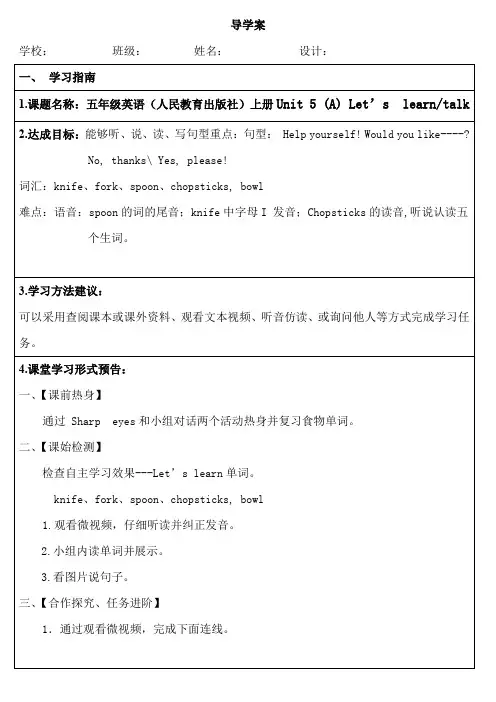
导学案学校:班级:姓名:设计:一、学习指南1.课题名称:五年级英语(人民教育出版社)上册Unit 5 (A) Let’s learn/talk2.达成目标:能够听、说、读、写句型重点:句型: Help yourself! Would you like----?No, thanks\ Yes, please!词汇:knife、fork、spoon、chopsticks, bowl难点:语音:spoon的词的尾音;knife中字母I 发音;Chopsticks的读音,听说认读五个生词。
3.学习方法建议:可以采用查阅课本或课外资料、观看文本视频、听音仿读、或询问他人等方式完成学习任务。
4.课堂学习形式预告:一、【课前热身】通过 Sharp eyes和小组对话两个活动热身并复习食物单词。
二、【课始检测】检查自主学习效果---Let’s learn单词。
knife、fork、spoon、chopsticks, bowl1.观看微视频,仔细听读并纠正发音。
2.小组内读单词并展示。
3.看图片说句子。
三、【合作探究、任务进阶】1.通过观看微视频,完成下面连线。
chopsticksknifeforkspoon2、When you eat the beef.___ is on the right.(右)___ is on the left.(左)A、 B、C、2、观看Let’s talk 视频,在文中圈出所学学单词。
3、角色扮演,师生、生生朗读对话。
4、听读课文录音,表演课文对话。
5、小组合作完成创编对话。
四、【拓展延伸】创编对话 .二、学习任务1、观看课本P51-52视频(有条件的学生可以提前观看教师下发的微视频),听音跟读三遍,思考并完成任务单上的练习。
三、困惑与建议在自主学习过程中,我遇到的困惑:。
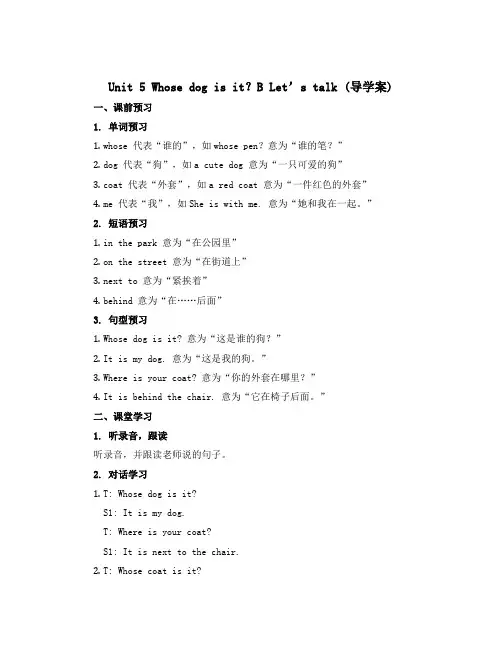
Unit 5 Whose dog is it?B Let’s talk (导学案)一、课前预习1. 单词预习1.whose 代表“谁的”,如whose pen?意为“谁的笔?”2.dog 代表“狗”,如a cute dog 意为“一只可爱的狗”3.coat 代表“外套”,如a red coat 意为“一件红色的外套”4.me 代表“我”,如She is with me. 意为“她和我在一起。
”2. 短语预习1.in the park 意为“在公园里”2.on the street 意为“在街道上”3.next to 意为“紧挨着”4.behind 意为“在……后面”3. 句型预习1.Whose dog is it? 意为“这是谁的狗?”2.It is my dog. 意为“这是我的狗。
”3.Where is your coat? 意为“你的外套在哪里?”4.It is behind the chair. 意为“它在椅子后面。
”二、课堂学习1. 听录音,跟读听录音,并跟读老师说的句子。
2. 对话学习1.T: Whose dog is it?S1: It is my dog.T: Where is your coat?S1: It is next to the chair.2.T: Whose coat is it?S2: It is my coat.T: Where is your dog?S2: It is in the park.3. 表演练习学生分角色进行对话表演。
4. 作业任务完成P58页的Let’s talk题目练习。
复述今天的内容,并写一篇短文介绍你的宠物。
三、课后延伸1. 选择题1.Whose pen is it?A. His pen.B. Her pen.C. Your pen.2.Where is the duck?A. It is in the river.B. It is on the tree.C. It is behind the tree.3.Whose cat is it?A. It is my cat.B. It is his cat.C. It is her cat.2. 完形填空Tom has a cute dog. 1 is a white dog with black eyes and nose. Tom 2 his dog very much. He often takes his dog 3 a walk in the park. One day, he took his dog to a street. A little girl saw the dog and asked, “4dog is it?” Tom answered, “It is 5dog.” The little girl said, “I like your dog very much.” Tom 6saying, “Thank you.” They wal ked 7and saw a coat behind the tree. Tom asked the little girl, “8 is thecoat?” The little girl said, “It is my coat. Thank you for 9my coat.” Tom said, “You’re 10.”1.A. They B. Them C. It2.A. love B. likes C. hates3.A. on B. in C. for4.A. Who’s B. What’s C. Where’s5.A. her B. his C. my6.A. said B. says C. say7.A. away B. near C. to8.A. Where B. Who C. What9.A. find B. finding C. finds 10.A. welcome B. sorry C. glad3. 组句子1.Whose cat / it / is / ? __________________________________________2.on the desk / my book / is / .__________________________________________3.is / coat / your / where / ?__________________________________________4.in the park / is / my dog / .__________________________________________4. 写作练习介绍你的宠物。
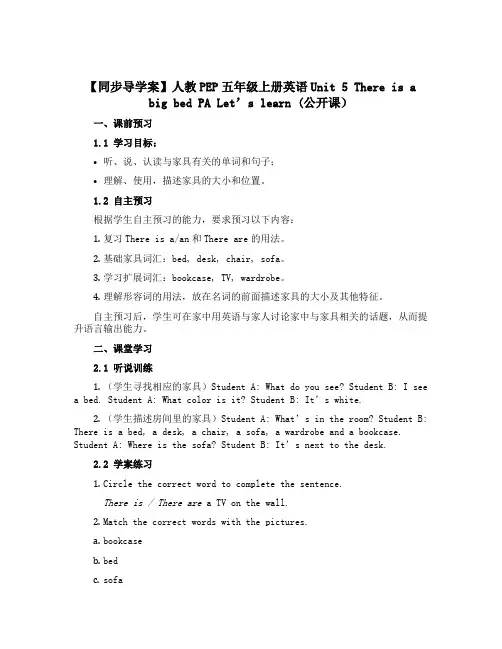
【同步导学案】人教PEP五年级上册英语Unit 5 There is a big bed PA Let’s learn (公开课)一、课前预习1.1 学习目标:•听、说、认读与家具有关的单词和句子;•理解、使用,描述家具的大小和位置。
1.2 自主预习根据学生自主预习的能力,要求预习以下内容:1.复习There is a/an和There are的用法。
2.基础家具词汇:bed, desk, chair, sofa。
3.学习扩展词汇:bookcase, TV, wardrobe。
4.理解形容词的用法,放在名词的前面描述家具的大小及其他特征。
自主预习后,学生可在家中用英语与家人讨论家中与家具相关的话题,从而提升语言输出能力。
二、课堂学习2.1 听说训练1.(学生寻找相应的家具)Student A: What do you see? Student B: I seea bed. Student A: What color is it? Student B: It’s white.2.(学生描述房间里的家具)Student A: What’s in the room? Student B: There is a bed, a desk, a chair, a sofa, a wardrobe and a bookcase. Student A: Where is the sofa? Student B: It’s next to the desk.2.2 学案练习1.Circle the correct word to complete the sentence.There is / There are a TV on the wall.2.Match the correct words with the pictures.a.bookcaseb.bedc.sofad.deske.chairf.wardrobe2.3 课后作业1.听读课文。
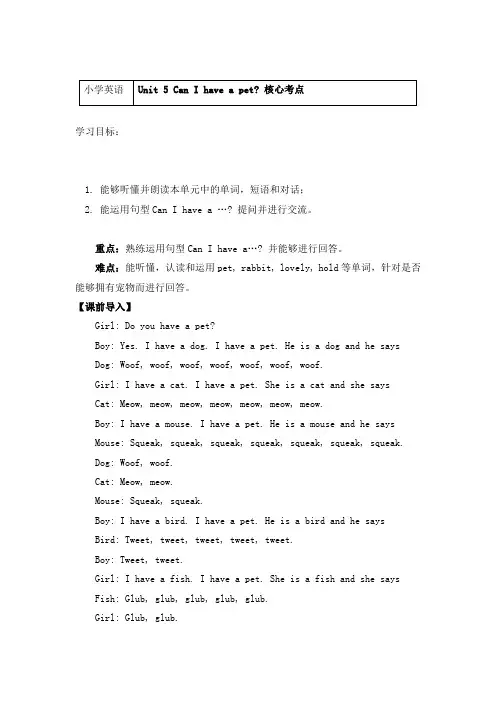
学习目标:1. 能够听懂并朗读本单元中的单词,短语和对话;2. 能运用句型Can I have a …? 提问并进行交流。
重点:熟练运用句型Can I have a…? 并能够进行回答。
难点:能听懂,认读和运用pet, rabbit, lovely, hold等单词,针对是否能够拥有宠物而进行回答。
【课前导入】Girl: Do you have a pet?Boy: Yes. I have a dog. I have a pet. He is a dog and he says Dog: Woof, woof, woof, woof, woof, woof, woof.Girl: I have a cat. I have a pet. She is a cat and she saysCat: Meow, meow, meow, meow, meow, meow, meow.Boy: I have a mouse. I have a pet. He is a mouse and he saysMouse: Squeak, squeak, squeak, squeak, squeak, squeak, squeak.Dog: Woof, woof.Cat: Meow, meow.Mouse: Squeak, squeak.Boy: I have a bird. I have a pet. He is a bird and he saysBird: Tweet, tweet, tweet, tweet, tweet.Boy: Tweet, tweet.Girl: I have a fish. I have a pet. She is a fish and she says Fish: Glub, glub, glub, glub, glub.Girl: Glub, glub.Boy: I have a lion.Girl: A lion?Boy: I have a pet. He is a lion and he says roar, roar, roar, roar, roar, roar, roar.Bird: Tweet, tweet.Fish: Glub, glub.Boy and girl: Roar~考点:【词汇精讲】1. pet n. 宠物pet是可数名词,其复数形式为pets。

精选文档课题: Module2 Unit1 MeListen and say ,Do a survey ( Period1)单位鲍店一寄年级五科目英语备课教师王玉平小1、单词: at (time ), home家, morning ,学习目标:2、句型: -What time do youat (time )?-I at ( time ).教课要点:句型: -What time do youat (time )?-I at ( time ).教课难点:学会用英语咨询在何时做某事及回答教课流程二次设计一、课前导入:你能试着写出下边的时间吗?六点钟 6:00 ,七点钟 7:00 ,七点半 7:30 ,三点半 3:30 .二、新知体现:1、单词: at (time),home, morning;2、短语: come home,in the morning;3、句型① -What time do you at(time)?-I at(time).②Ben gets up at三、沟通展现:1、依据汉语补全句子。
(1)I at six o’clock.(我六点起床 )(2)I at seven o’clock.(我七点上学 )(3)I at half past three.我(三点半回家 )( 4) He at half past eight.(他八点半看电视 )( 5) What time you go to bed ?(你几点睡觉 )四、自我检测:()1、They get up half past six in the morning.A. inB.onC.at( ) 2、Ben home at nine o’clock.A.doese ( ) 3、- do you do your homework?-I do my homework at 7:30.A.What timeB.HowC.What ( ) 4、Ben home at six o’clock.A.doese2、用动词的适合形式填空:① .I(eat) my dinner at half past seven.② .Ben(come) home at six o’clock.③ .We(watch) TV at half past eight.五、拓展提高:写一写你一天的生活Every day I am very happy. I get up at 6:00. I go to school at清点收获:课题: Module2 Unit1 Me Look and read, Say and act(Period2)单位鲍店一寄五科目英语备课教师王玉平年级小1、单词: night ,chase,mice, outside学习目标:2、短语:at night, in the evening3、句型: They at (time) in the morning \evening.1、单词: night ,chase,mice, outside教课要点:2、短语:at night, in the evening差别 at ninght与in the evening教课难点:教课流程二次设计一、课前导入:你会选下边的词汇吗?go outside,eat(their)dinner,chase mice,go home,wash one’s face,go to bed,(1)吃晚饭(2)吃些鱼( 3)追老鼠(4)洗脸( 5)回家(6)上床睡觉二、新知体现:1、单词: night ,chase,mice,outside2、短语:at night, in the evening3、句型: They at (time) in the morning \evening.三、沟通展现:来吧 !连一连at seven o’clock in the evening(在)清晨六点半at nine o’clock at night(在)夜晚七点钟at half past six in the morning(在)夜晚九点钟四、自我检测:()1、They wash their faces7:00 o’clockthe morning .A. at onB.at inC.at at ()2、 Lucy and Lily to school at 7:30 in the morning .A.goesB.goingC.go()3、What time Kitty do her homework?A.doB.doesC.did五、拓展提高:问答句般配:() 1、 Do you go to shool at 8:00 in the morning ? ()2、What time do you watch television ?()3、What time do you read English ?A 、At 9:00 in the morning .B、No, I go to school at 7;30.C、I watch television at 8 o’clock in the evening .清点收获。

Unit 5 What does he do导学案共6课时Unit 5 What ddo?Period学习目标:1.能够运用主要句型询问某人的职业并作答“What does your father/mother do? He's/She's a/an…”2.完成听力练习以及利用以上重点句型进行口语训练。
一. Review to understand.(温故知新)wudo the aa(图句选择,两人一组朗读并做动作。
)A B C D( )1.I like singing. ( )2.I like making a( )3.I like playing ping-pong. ( )4. I like reading b( )5.I like playing the guitar.二.Warm-up(热身活动)Fill the blanks.(用Do 或Does填空。
)⑴. ________ he teach math? ⑵. ________ you like English?⑶. ________ your father like music? ⑷.________ you have a sharpener?2ght word accordinganings.(根据汉语意思选择合适的单词,完成句子。
)⑴. I am a ___________(清洁工). ⑵. He is a______(教师).⑶. My f aa __________(医生). ⑷. Linda is a ________(农民).⑸al is a _____________(司机). (6).Tom is an (艺术家).三.Self check(自学检测)1.Read the dialogue and answer the qu(读课本48页对话,回答下面问题。
)(1).What does Oliver’s father do?(2).What does Oliver’do?(3).Does Oliver want to be a businessman? 2and fill the blanks.(选词填空。
Unit 5 Can I have a pet?(导学案)教学目标1.掌握以下单词:pet, dog, cat, fish, bird, rabbit, hamster, turtle。
2.能够表达自己想拥有的宠物及原因。
3.发展对话交流能力及听力能力。
4.能够阅读并理解简单的英文描述。
教学重点能够表达自己想拥有的宠物及原因。
教学难点发展对话交流能力及听力能力。
教学准备教师:课件,实物宠物图片学生:笔,笔记本教学过程Step1:导入新课(10分钟)1.跟学生们打招呼,问好并介绍今天我们学什么。
2.呈现一些可爱的宠物的图片,跟学生们一起讨论有哪些宠物,问学生是否有过自己心仪的宠物。
3.引导学生阅读本单元标题为 Can I have a pet?Step2:学生自我介绍(10分钟)1.教师询问学生们是否想要拥有依靠自己照顾的宠物。
2.要求学生拿出自己准备好的笔记本,把自己想拥有的宠物写下来,并给出一个原因,如:I want to have a dog because it can play with me and protect me.3.鼓励学生互相分享自己的想法,提高学生们的自信和表达能力。
Step3:老师介绍一些常见的宠物及它们的特点(20分钟)1.引导学生看课件中的图片。
让学生们猜测图片中是什么动物,如:What is this? Is it a dog? Is it a cat?2.老师介绍宠物的名称及特点,并呈现出实物宠物图片,让学生们可以亲自看到这些可爱的生物。
pet (宠物)dog (狗)cat (猫)fish (鱼)bird (鸟)rabbit (兔子)hamster (仓鼠)turtle (乌龟)3.老师发起问题,询问宠物的特点、食物、生活习性,并鼓励学生们一起回答问题。
Step4:播放听力,并完成听力练习(20分钟)1.播放本单元的听力材料。
2.让学生们听一遍,然后再听一遍,并请学生们把答案写在笔记本上。
英语导学案(教案)编号:2019-2020五年级课题Unit 5 There is a big bed 课型阅读课主备人审核人时间第四课时流程具体内容教法指导学习目标1.复习Unit5的知识重点。
2. Can understand story time part and know what happen in the story .Important &difficult points(重难点)1.Can master unit5 ‘s words and phrases2.Can use There is /There are 和位置关系。
自主学习1. Read these words and speak out Chinese meaning .clock plant bottle bike photo abovebeside between in front of2、Recite“ Let’s talk” part .3.Let’s check1).Listen to the tape and tick or cross.2).Listen again and write .There is a _____________on the desk .There are two _____________above the desk. Story time (准备头饰:monkey, bird, can, bear , rabbit, fish )3).Listen to the tape of story time .4).Students read this part .5)、Find out key’s sentences :There isa can beside the river.I want to go home .A naughty bear kicks the can…6、 Teach these key’s sentences.合作探究`1、Role play (让学生戴头饰扮演不同的人物表演整个故事)2、Repeat the story .(教师可给一些提示)3、Role play (main sentences: page46-47)所剩时间而定。
五年级上册英语导学案-Unit 5 Is this your schoolbagLesson27|人教(精通)课前预习本课主要学习词汇与句型:词汇•schoolbag 学校书包•ruler 直尺•pencil case 铅笔盒•eraser 橡皮擦•pencil 铅笔•pen 钢笔•pencil sharpener 卷笔刀句型1.—Is this your schoolbag?2.—Yes, it is. / No, it isn’t.请学生在预习时阅读课文,掌握以上词汇及句型,并进行相关的语音、语调练习。
课堂学习在课堂上,我将运用以下教学方式帮助学生更好地掌握本课内容:1. 听力训练播放课文录音,让学生聆听并模仿发音。
同时,通过听力练习让学生能够自然而然地掌握本课所学的词汇及句型。
2. 语言训练通过教师与学生的互动,操练本课所学的句型,确保学生能够熟练使用本课所学的语言知识。
3. 合作学习将学生分成小组,让他们利用所学的语言知识与技能完成任务。
例如,把教室里的物品分别放在桌子上,学生们需要在交流中找到自己的书包,同时也找到其他同学的书包,并最终建议让每个人把自己的物品放在什么位置。
4. 综合运用通过阅读、听力、写作等多种教学方式,综合运用本课所学的知识进行评估,确保学生能够真正地掌握本课的语言内容。
作业布置作业主要是巩固学生对本课所学的知识点的掌握。
记忆词汇请学生先进行词汇梳理,将学过的词汇进行整理与记忆。
书面表达根据学生自己的实际情况,写一篇50字左右的短文,介绍自己的学校书包。
课后延伸学生可以通过以下方式进行进一步训练:•利用网络资源与网上课程进一步提升学习效果。
•参加相关的英语考试或培训,提高自己的英语水平。
•参加学校的英语角活动,与其他同学进行交流与互动。
、隆德一小英语导学案课题:Unit5 There is a big bed Period 1学习目标:1.能听、说、读、写单词“clock,” “plant,” “bike,” “water bottle和“photo,并能用句型“There is表达某处有某物。
2. 能做“Let' s p部分的游戏。
3. 培养学生积极与他人合作的优良品质。
4. 教育学生要热爱自己的家。
教学重点:1.能听、说、读、写单词“clock,,“plant,” “bike,” “water bottle和“photo,并能用句型“There is表达某处有某物。
2. 能做“Let' s p部分的游戏。
教学难点:There be句型的简单运用。
学习准备:1.教师准备多媒体课件、录音机和录音带、图片、衣服实物。
2. 学生准备画笔和画纸。
一、课前自主复习引题二、课内探究(三) 合作探究(四) 知能应1. A. Let ' s learn(1)教学新单词T: First, let 'put a clock in the room.(教师边说边点击课件,房间的墙上出现一个钟表)Now there is a clock inthe room. Follow me, please. Clock, c-l-o-c-k, clock, there is a clock.教师用同样的方法引出词语:pla nt,water bottle, bike, photo(2) 教师用唱反调”的方式带领学生读几遍新词汇。
(3) 教师介绍张鹏的房间。
T: Do you know what Zhang Peng'room like? Let ' s go and see.(4) 第一次播放教学录音,全班学生跟着录音读,了解对话的大致内容。
⑸学生同桌合作,用句型“ There is ...介绍自己班级的物体。
2. A. Let ' s play(1)教师请三位学生上讲台,表演本部分的句子接龙”游戏。
(2)学生三人一组,模仿示例表演句子接龙”游戏,然后教师请两三组学生上讲台表演。
1) 跟录音,读单词2) 组长领读,组员跟读3) 分组展示4) 我会说There is...我会说There is...教师同时做指导三、课外延伸基础题一填入所缺字母,完成单词:① 瓶子bot ______ e ②钟clo _________ (自行车b ________ e ④水w __ t __ r ⑤片pho ___________ ⑥植物pl ________ t_ 、选出不同类的一项。
(10 分)( )1、A. toyB. pen cilC. cray on( )2、A. weB. theirC. my( )3、A. beh indB. emailC.under( )4、A. ballB. drawC. move( )5、A. mouse B. dog C. pla nt课后反思隆德一小英语导学案班级:姓名:—:杨芳五年级组编制课题:t5 There is a big bed Period 2学习目标:1.能听、说、认读单词“ there。
2. 能灵活运用There be句型介绍房间内有什么,并用适当的形容词描述房间内的物体。
3. 能完成“Let' s部部分的听力任务。
4. 激发学生与他人进行合作、交流的欲望,加强学生对彼此的了解。
教学重点:1.能听、说、认读单词“ there。
2.能灵活运用There be句型介绍房间内有什么,并用适当的形容词描述房间内的物体。
教学难点:1. There be句型的用法。
2.激发学生与他人进行合作、交流的欲望。
学习准备:1.教师准备多媒体课件、录音机和录音带、图片。
2.学生准备画笔和画纸、人物头饰。
一、课前自主复习引题二、课内探究裙讲占拨z(\A. Let ' s talk1. 教师再次出示自己的卧室图 片,让学生同桌用There be 句型 说一说卧室里面有什么,并对卧 室里的物体进行评价,如: S1: There is a water bottle in the bedroom.S2: Oh, it ' s nice.S1: There is a photo on the wall. S2: I like the photo.2. 介绍对话情景T: There is a photo of Zhang Pengs room. Sarah and Zhang Peng are talki ng about the room. Let ' s listen to the tape and know someth ing about their talk ing. 3. 第一次播放教学录音,全班学 生跟着录音读。
第二次播放教学录音,学生听完 录音后回答下面冋题:① Is Zhang Peng ' s room nice ② Is the bed big or small? ③ Where is the computer? An swer:① Yes, it is. ② It ' s big.③ It ' s on the desk.第三次播放教学录音,全班学生 跟着录音读,提醒学生在跟读的 过程中药注意模仿录音中的语 音、语调。
4. 学生拿出人物头饰,同桌合作 练习表演对话,然后教师请几对 学生上讲台表演,评选出 最佳 表演者”,并给予小礼物作为奖 励。
5. Describe the picture教师出示情景图,学生用 There be 句型描述房间里有些什么物 体。
?(三)合作结对练习对话探(四)知能应用学生结对合作,一名学生用自己学习过的句型(如:I have -There is / are…)描述自己的房间,另一名学生根据描述在空房间内画出相应的物品,然后交换角色练习。
比一比谁画得更像、更好。
教师同时做指导(五)总结拓展今天,你有什么收获? 单词:句型:三、课外延伸一基础题( ) ①This is bedroom.A.I B. my C. me( ) ②There a photo on the wall.A. isB. areC. be( ) ③- -Is this your coat?- .A. Y es, it isnB. Nd, it isnC.'Nb , it is. ( ) ④ In my room I have two big __________ .A. bikeB. bikesC. a bike二、选择填空。
( )1.There ____a small bike in my bedroom.A. amB. isC. areD. be( )2.There _____ s ome pictures on the wall.A. amB. isC. areD. be( )3.My father has ______ pictures.A. aB. anC. manyD. \( )4.Tom is behi nd Jim, Jim is ______ Tom.A. frontB. in front ofC. overD. beh ind()5.There is a TV _________ t he bed.A. n earB. inC. un derD. behi nd课后反思隆德一小英语导学案班级:—_ 姓名:_…主备人:一杨芳五年级组编制课题:t5 There is a big bed Period 3学习目标:1.通过大量的听读操练,掌握双元音字母/ei/在单词中的发音,让学生感悟一些信息英语语音的方法。
2. 完成“Let' s witapp部分的连线和填空任务,掌握There be句型中be动词单复数形式的运用。
3. 能听懂、会唱歌曲“ A photo of me> ”4. 培养学生积极学习的精神和合作学习的态度。
教学重点:1.通过大量的听读操练,掌握双元音字母/ei/在单词中的发音,让学生感悟一些信息英语语音的方法。
2. 完成“ Let wrap itup"部分的连线和填空任务,掌握There be句型中be动词单复数形式的运用。
教学难点:1.双元音/ei/在单词中的发音。
2.提高学生的英语听力能力。
学习准备:教师准备多媒体课件、录音机和录音带。
一、课前自主复习引题二、课内探究A. Let ' s spell1. Read, liste n and cha nt(1) 呈现例词教师用多媒体依次呈现本部分的图片,引出例词,并把例词写在黑板上。
rainy rain bow paint wait say way birthday Mon day(2) 播放本部分的教学录音,全班跟着录音读,提醒学生在跟读时要注意模仿录音中的发音,尽量做到读准元音字母的发音。
(3) 学生在四人小组内依次读例词,尝试找出例词的发音规律。
(4) 教师总结:第一行单词中的字母组合“ a和第二行单词中字母组合“ ay在单词中都发/ei/音。
(5) 教师简单讲解发音要领:发双元音/ei/时,口型由/e/向/i/滑动,下巴向上合拢,舌位随之抬高。
注意双元音的发音特点是前重后轻、前长后短。
2. Liste n, read and circle(1) 教师先带领学生将本部分的单词读几遍,然后让学生分组读、分男女生读。
(2) 播放本部分的教学录音,学生根据录音内容圈出正确的选项。
(3) 再次播放教学录音,师生一起核对答案。
3. Look, liste n and write(1) 先让学生观察本部分的图片,然后教师播放教学录音,全班学生根据录音内容填空。
(2) 再次播放教学录音,师生一起核对答案。
三、课外延伸基础题一找出画线部分读音不同的一项。
( )1.A .say_ B.may _C.sunny ( )2.A.rain _B.card CTuesday ( )3.A.always _B.apple _ C.day ()4A. name_ B.play Cbag二单项选择( )I.This is a picture _____ my room.A. onB. inC. ofD. to( )2.My father can draw very _______ .A. goodB. wellC. prettyD. beautiful( )3.Two photos _______ n ear the bed.A. amB. isC. areD. be( )4.There _______ a desk, a TV and two sofas in my room.A. isB. amC. areD. be( )5.We are rabbits. We _____ a new house.A. haveB. hasC. isD. are课后反思隆德一小英语导学案班级:—_ 姓名:_…主备人:一杨芳五年级组编制课题:t5 There is a big bed Period 4学习目标:1.能听、说、读、写表示位置关系的单词“ front,”“ betwee n”“ above” “ beside ” “ behinc和词组“ in front of。